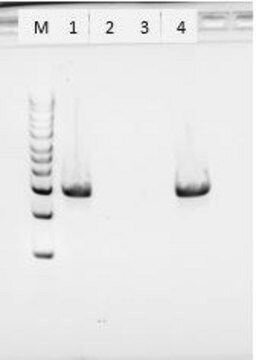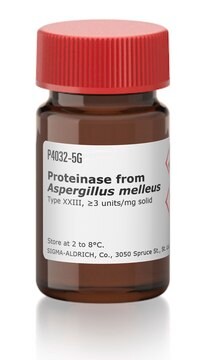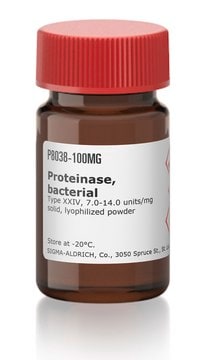Kluczowe dokumenty
SAE0009
Proteinase K from Tritirachium album
≥30 units/mg protein
Synonim(y):
Endopeptidase K
About This Item
Polecane produkty
pochodzenie biologiczne
fungus (Tritirachium album)
Poziom jakości
Formularz
lyophilized powder
aktywność właściwa
≥30 units/mg protein
masa cząsteczkowa
28.93 kDa
metody
DNA extraction: suitable
obecność zanieczyszczeń
DNAse, RNAse, none detected.
temp. przechowywania
−20°C
Szukasz podobnych produktów? Odwiedź Przewodnik dotyczący porównywania produktów
Opis ogólny
Zastosowanie
It is used for the removal of endotoxins bound to cationic proteins such as lysozyme and ribonuclease A.
It is useful for the isolation of hepatic, yeast, and mung bean mitochondria and is used to determine enzyme localization on membranes
It is used for the treatment of paraffin embedded tissue sections to expose antigen binding sites for antibody labeling and for digestion of proteins from brain tissue samples for prions in Transmissible Spongiform Encephalopathies (TSE) research. Product SAE0009 is provided as a lyophilized powder. Product SAE0009 has been used to break down human lens protein1.
Removes endotoxins that bind to cationic proteins such as lysozyme and ribonuclease A.
Reported useful for the isolation of hepatic, yeast, and mung bean mitochondria
Determination of enzyme localization on membranes
Treatment of paraffin embedded tissue sections to expose antigen binding sites for antibody labeling.
Digestion of proteins from brain tissue samples for prions in Transmissible Spongiform Encephalopathies (TSE) research.
Działania biochem./fizjol.
Definicja jednostki
Hasło ostrzegawcze
Danger
Zwroty wskazujące rodzaj zagrożenia
Zwroty wskazujące środki ostrożności
Klasyfikacja zagrożeń
Eye Irrit. 2 - Resp. Sens. 1 - Skin Irrit. 2 - STOT SE 3
Organy docelowe
Respiratory system
Kod klasy składowania
11 - Combustible Solids
Klasa zagrożenia wodnego (WGK)
WGK 1
Temperatura zapłonu (°F)
Not applicable
Temperatura zapłonu (°C)
Not applicable
Wybierz jedną z najnowszych wersji:
Certyfikaty analizy (CoA)
Nie widzisz odpowiedniej wersji?
Jeśli potrzebujesz konkretnej wersji, możesz wyszukać konkretny certyfikat według numeru partii lub serii.
Masz już ten produkt?
Dokumenty związane z niedawno zakupionymi produktami zostały zamieszczone w Bibliotece dokumentów.
Klienci oglądali również te produkty
Nasz zespół naukowców ma doświadczenie we wszystkich obszarach badań, w tym w naukach przyrodniczych, materiałoznawstwie, syntezie chemicznej, chromatografii, analityce i wielu innych dziedzinach.
Skontaktuj się z zespołem ds. pomocy technicznej









